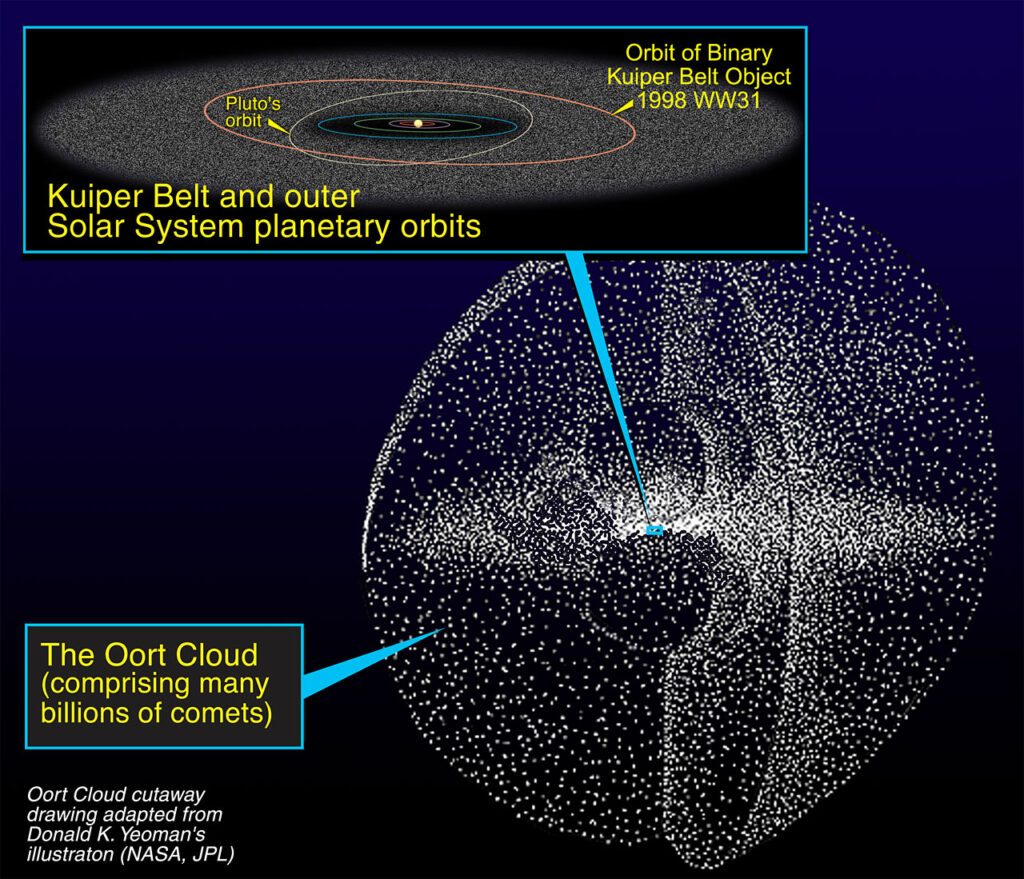A Comparative Study of Distant Solar System Reservoirs
© ESO/L. Calçada
Unveiling the mysteries beyond the orbits of planets, this page illuminates Kuiper Belt vs Oort Cloud – two distinct regions teeming with icy celestial bodies, offering vital insights into the evolution of our solar system.
The outer reaches of our solar system hold a vast and enigmatic realm that has long captivated the curiosity of astronomers and space enthusiasts alike. Two distinct regions, the Kuiper Belt and the Oort Cloud, serve as reservoirs of celestial bodies that orbit far from the Sun, shaping the dynamic landscape of our cosmic neighbourhood. In this exploration, we embark on a comparative journey, seeking to unveil the differences and similarities between these two distant frontiers.
The Kuiper Belt, situated just beyond the orbit of Neptune, and the Oort Cloud, an even more remote realm enveloping the solar system, represent pivotal components in our understanding of the solar system’s formation, composition, and dynamics. As we delve into their unique attributes and delve deeper into the mysteries they hold, we uncover the contrasting tales of icy worlds, comets, and the profound influence they exert on the inner reaches of our planetary system.
FORMATION AND ORIGIN (KUIPER BELT VS OORT CLOUD)

The formation and origins of the Kuiper Belt and the Oort Cloud, two distant and intriguing regions of the solar system, provide critical insights into the early history and dynamics of our cosmic neighbourhood. While these regions share some commonalities, they also exhibit distinct characteristics and formation mechanisms.
KUIPER BELT
The Kuiper Belt, a vast region beyond the orbit of Neptune, is a dynamic reservoir of icy bodies, asteroids, and dwarf planets. Its formation can be attributed to the same processes that shaped the rest of the solar system:
SOLAR NEBULA
It all began with the formation of the solar system from a massive cloud of gas and dust known as the solar nebula. As the Sun ignited and its gravity exerted influence, the nebula’s material began to coalesce into a central star and surrounding objects.
EARLY DYNAMICS
During the early phases of solar system formation, the Kuiper Belt’s precursor objects, or “planetesimals,” emerged from the protoplanetary disk. These were small, icy bodies that later served as the building blocks for larger Kuiper Belt objects.
GRAVITATIONAL INFLUENCE
The gravitational interactions between these planetesimals, as well as with the giant planets, played a pivotal role in shaping the Kuiper Belt. In particular, Neptune’s influence scattered many objects outward, contributing to the formation of the Kuiper Belt.
STABILITY
Objects within the Kuiper Belt settled into stable orbits, including resonances with Neptune, where specific ratios of their orbital periods aligned with Neptune’s, leading to stable configurations.
CONTINUED EVOLUTION
Over billions of years, the Kuiper Belt continued to evolve through collisions, impacts, and occasional interactions with passing stars or nearby stellar events. These processes have contributed to the diverse population of objects we observe today.
OORT CLOUD
The Oort Cloud, in stark contrast, is an even more distant and mysterious realm, enveloping the solar system at its outermost fringes. Its formation represents a fundamentally different process:
PRIMORDIAL ICES
The Oort Cloud’s origins are traced back to the early stages of the solar system when primordial ices and dust grains existed far from the young Sun. These ices included water, ammonia, and methane, among others.
SCATTERING AND GRAVITATIONAL INTERACTIONS
Early gravitational interactions and perturbations by the giant planets, especially Jupiter and Saturn, caused some of these icy objects to be flung outward to the distant reaches of the solar system.
FORMATION OF THE CLOUD
As these objects moved farther from the Sun, they entered a region where the Sun’s gravitational influence waned significantly. Over time, these icy bodies coalesced into the vast and diffuse sphere of the Oort Cloud.
DYNAMIC INTERACTIONS
The Oort Cloud is not a static, uniform structure but rather a dynamic zone where objects are influenced by passing stars and the galactic tide. These interactions can occasionally send comets from the Oort Cloud hurtling toward the inner solar system.
LOCATION AND DISTANCE (KUIPER BELT VS OORT CLOUD)

The Kuiper Belt and the Oort Cloud are two distinct regions in the outer solar system, each located at vastly different distances from the Sun. Their locations and distances play a crucial role in shaping their characteristics and dynamics. Here, we delve into the specifics of where these two regions are situated relative to the Sun:
KUIPER BELT
LOCATION
The Kuiper Belt is a relatively well-defined region of the solar system that lies just beyond the orbit of Neptune, the eighth planet from the Sun.
DISTANCE
The Kuiper Belt extends from about 30 astronomical units (AU) to approximately 50 AU from the Sun. One AU is the average distance between the Earth and the Sun, roughly 93 million miles (150 million kilometers).
CHARACTERISTICS
This region is populated with a diverse array of objects, including small icy bodies, asteroids, and dwarf planets. Its proximity to the Sun allows for relatively easier observation and study compared to the more distant Oort Cloud.
OORT CLOUD
LOCATION
The Oort Cloud is an exceedingly remote region enveloping the solar system, lying at the outermost fringes.
DISTANCE
The Oort Cloud’s distance from the Sun is immense, spanning from approximately 2,000 AU to as far as 100,000 AU or more. Objects in the inner Oort Cloud are closer to the Sun, while those in the outer Oort Cloud are extremely distant.
CHARACTERISTICS
This region is comprised of a vast, diffuse sphere of icy bodies, including comets, in a largely unstructured and extended configuration. Objects in the Oort Cloud are so distant that they are seldom observed directly from Earth.
COMPOSITION (KUIPER BELT VS OORT CLOUD)

The composition of objects in the Kuiper Belt and the Oort Cloud, two distant and diverse regions of the solar system, varies significantly due to their distinct locations, formation processes, and histories. Let’s explore the differences in composition between these two outer solar system domains:
KUIPER BELT
ICE
Objects in the Kuiper Belt are predominantly composed of ice, which includes water ice, methane ice, ammonia ice, and other volatile compounds. These ices make up a significant portion of their mass.
ROCKY MATERIAL
In addition to ices, Kuiper Belt objects contain smaller amounts of rocky material, such as silicates and other minerals. This rocky component typically forms the object’s core and is surrounded by layers of volatile ice.
ORGANIC COMPOUNDS
Many Kuiper Belt objects exhibit the presence of organic compounds, including complex hydrocarbons and tholins. These compounds are thought to have formed through chemical reactions in the presence of ultraviolet (UV) radiation from the Sun.
REDDISH COLOURATION
A notable feature of Kuiper Belt objects is their reddish or brownish colouration, which is often attributed to the presence of complex organic compounds on their surfaces. These compounds are generated by the irradiation of ice by cosmic rays and UV light.
SURFACE VARIABILITY
The specific composition and surface characteristics of Kuiper Belt objects can vary from one object to another. Some areas may be dominated by water ice, while others may contain methane or other volatile ice.
OORT CLOUD
PRIMORDIAL ICES
Objects in the Oort Cloud are believed to be composed primarily of primordial ices, including water ice, ammonia ice, and methane ice. These ices are remnants from the early solar system and have been preserved at extremely low temperatures in this remote region.
LESS ROCKY MATERIAL
Compared to the Kuiper Belt, the Oort Cloud is expected to have a lower proportion of rocky material. It consists primarily of volatile ices that have remained largely undisturbed for billions of years.
LESS ORGANICS
While some organic compounds may be present in the Oort Cloud, they are likely to be less abundant and diverse than those found in the Kuiper Belt. The extreme cold and isolation of the Oort Cloud limit the complexity of organic chemistry.
SOURCE OF COMETS
One of the defining characteristics of the Oort Cloud is its role as the source of long-period comets. These comets, composed primarily of ice, are believed to originate from the inner regions of the Oort Cloud and venture into the inner solar system when perturbed by gravitational interactions.
ORBITAL CHARACTERISTICS (KUIPER BELT VS OORT CLOUD)

The orbital characteristics of objects in the Kuiper Belt and the Oort Cloud differ significantly due to their distinct locations and formation histories within the solar system. Here, we explore the differences in the orbital characteristics of these two outer solar system regions:
KUIPER BELT
PROXIMITY TO THE SUN
The Kuiper Belt is relatively close to the Sun compared to the Oort Cloud, with objects orbiting beyond the orbit of Neptune, the eighth planet.
ORBITAL DISTANCES
Kuiper Belt objects typically have semi-major axes (average orbital distances) that range from about 30 astronomical units (AU) to approximately 50 AU. This places them within the gravitational influence of Neptune.
ECCENTRICITIES
The orbits of Kuiper Belt objects can exhibit varying degrees of eccentricity, meaning they are more or less elongated. Some KBOs have nearly circular orbits, while others have highly elliptical orbits.
STABILITY
Some resonant orbits with Neptune are stable over long periods, contributing to the structure and stability of the Kuiper Belt. However, others may be unstable and result in objects being perturbed into different orbits or ejected from the Kuiper Belt.
OORT CLOUD
EXTREME DISTANCE
The Oort Cloud is situated at an extreme distance from the Sun, encompassing the outermost fringes of the solar system.
ORBITAL DISTANCES
Objects in the Oort Cloud can have semi-major axes that extend from approximately 2,000 astronomical units (AU) to as far as 100,000 AU or more. This places them in a region where the Sun’s gravitational influence is exceedingly weak.
HIGH ECCENTRICITIES
The orbits of Oort Cloud objects are highly eccentric, meaning they are extremely elongated. These orbits can have eccentricities approaching or exceeding 1, resulting in orbits that are nearly parabolic or hyperbolic.
RARE INTERACTIONS
Objects in the Oort Cloud are subject to rare gravitational interactions with passing stars, as well as the gravitational influence of the galactic tide. These interactions can perturb their orbits and occasionally send comets from the Oort Cloud into the inner solar system.
In conclusion, Kuiper Belt vs Oort Cloud stand as two enigmatic and distinct realms in the outer reaches of our solar system. While both of these regions are characterized by icy objects, their differences in location, formation, and orbital characteristics set them apart as unique and fascinating frontiers.
The Kuiper Belt, situated just beyond Neptune’s orbit, is a comparatively nearby domain with a diverse population of objects. These Kuiper Belt objects exhibit a wide range of compositions, including ice, organic compounds, and rocky materials. Their orbits often feature resonances with Neptune, adding stability and structure to this region.
In contrast, the Oort Cloud resides at the fringes of the solar system, encompassing immense distances and maintaining extreme gravitational isolation from the Sun. Objects in the Oort Cloud are primarily composed of primordial ices, and their orbits are characterized by extreme eccentricities, making them prone to rare gravitational interactions with passing stars. As we continue to explore and study these two outer solar system domains, we deepen our comprehension of the broader cosmic landscape and the processes that have shaped our planetary neighbourhood. The Kuiper Belt and the Oort Cloud remind us of the vast and diverse nature of our solar system, inspiring further investigation into the mysteries of these distant and intriguing frontiers.
